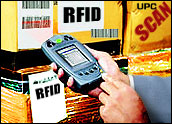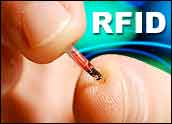
Without a doubt, adoption and use of radio frequency identification (RFID) accelerated dramatically when Wal-Mart and the Department of Defense (DoD) gave their respective suppliers marching orders to implement the technology.
However, suppliers for the most part were not happy with the additional costs and resources that had to be diverted into these projects — expenditures that would not benefit them except in keeping the business.
Forward-Looking Firms
In short, as outlined in Part 1 of this two-part series, most suppliers that are complying with the mandates are doing it because they must.
Nevertheless, at the same time, some forward-looking companies are experimenting with RFID technologies to solve a variety of internal productivity issues, including maintaining traffic flow in a crowded parking garage and returning errant shopping carts that can cost a surprising US$200 per cart.
These are interesting and sexy uses of a technology that until recently was seen as staid and one-dimensional.
However, RFID technology basically is best suited for the supply chain — at least that is where the greatest efficiencies on the largest scale can be realized with its deployment.
Who Killed RFID?
Unfortunately, the Wal-Mart initiatives — and, to a lesser extent, the DoD efforts — have squashed any independent interest of experimenting with this technology in the supply chain, Doug Standley, an analyst with Deloitte Consulting who covers RFID technology, told CRM Buyer.
“The results for vendors complying with the mandates so far have been disappointing,” he noted.
“RFID has been given a bad reputation by Wal-Mart, which has branded RFID around chip-based passive technology,” Standley added.
However, a growing body of research, product development and pilot project deployments are finding that significant value can be extracted from an RFID investment in the supply chain, he commented.
The Current State
Right now, the conventional deployment is to link asset tracking to RFID. When that deployment is extended to asset management using new sensor-based technologies, firms are finding they reap significantly more gains, Standley explained.
These deployments usually leverage one mechanism for data entry, but then take advantage of other devices or technologies besides bar codes.
For instance, a “smart shelf” deployment — that is, sensor-based technology coupled with RFID — could alert a retailer when a shelf was empty or nearing that state. Every item on that shelf wouldn’t necessarily have to be tagged, but the sensors can judge by weight whether or not the products for sale are dwindling.
The result for retailers is not having to maintain as much inventory on-site and using fewer people for what were once manual tasks, Standley said.
Cold Chain
Consumer goods manufacturers are also starting to experiment with RFID in the so-called “cold chain” — that is, food products and other goods that need to be stored and transported at a certain temperature.
A produce distributor can correlate the temperature of its goods along with location and time data to know exactly where and for how long a container of frozen food was inadvertently expose to higher temperatures, Martyn Mallick, Sybase iAnywhere’s director of RFID technologies, explained to CRM Buyer.
“This is done by combining location data with RFID data,” he noted. With this information, producers are becoming more creative in the way they interact with customers.
“Let’s say a producer realized a pallet of produce was sitting outside for half a day when it shouldn’t have and that knocked two days off of it shelf life. The producer can look to see if the retailer is nearby in order to get on the shelf right away,” Mallick explained. The producer then gives the retailer a discount for the produce, which is a better deal than having to throw away the entire shipment, he added.
The Plant Floor
Nevertheless, manufacturing plants are probably the most active in experimenting with RFID technology — with many companies pushing past previous uses.
Late last year, Honda Italia launched an RFID pilot program with IBM Global Business Services to monitor components, work in progress and inventory replenishment related to production of the Hornet 600, one of its motor bikes.
While the project started out on a piecemeal basis, it has been very important to the company and closely watched for future uses, Nicola Marrone, a project executive at Honda Italia, told CRM Buyer.
“Benefits will include lower costs, improved time to market and reduced assembly line stops,” he stated.
Not only is each each vehicle in the production chain tagged, but the RFID technology can also be used on micro-lots of critical components, such as engines. Future plans call for RFID tags to applied to Honda’s entire scooter production line, including the SH150i/125i and the bigger SH300i.
These systems will be then be integrated with Honda’s existing IT infrastructure through a Linux and Java application built on the IBM WebSphere Application Server to better track inventory.
Right now, it is basically an internal productivity play. Next up? Honda Italia plans to extend RFID into after sales service and the supply chain, Marrone concluded.






















































